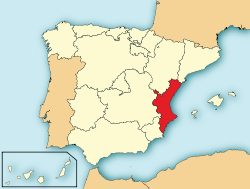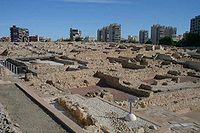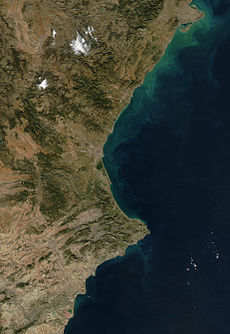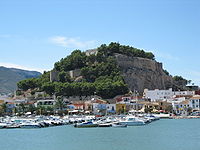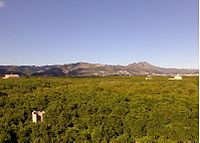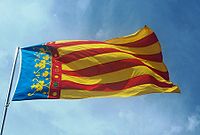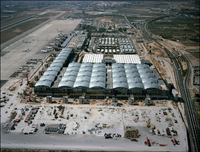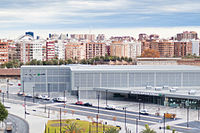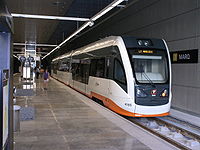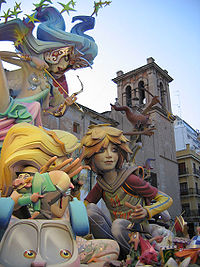- Valencian Community
-
This article is about the autonomous community. For other uses, see Valencia (disambiguation).
Valencian Community
Comunitat Valenciana (Valencian)
Comunidad Valenciana (Spanish)— Autonomous Community — Comunitat Valenciana1 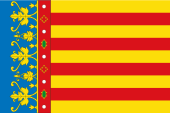
Flag
Coat of armsAnthem: Himne de l'Exposició Location of the Valencian Community Coordinates: 39°30′N 0°45′W / 39.5°N 0.75°WCoordinates: 39°30′N 0°45′W / 39.5°N 0.75°W Country Spain Capital Valencia Provinces Alicante, Castellón, and Valencia Government – Type Devolved government in a constitutional monarchy – Body Generalitat Valenciana – President Alberto Fabra Part (PP) Area – Total 23,255 km2 (8,978.8 sq mi) Area rank 8th (4.6% of Spain) Population (2009) – Total 5,111,706 – Density 219.8/km2 (569.3/sq mi) – Pop. rank 4th (10.6% of Spain) Demonym Valencian
valencià (m), valenciana (f)
valenciano/a (m/f)Time zone CET (UTC+1) – Summer (DST) CEST (UTC+2) ISO 3166-2 VC Area code +34 96 Official languages Valencian (known as Catalan elsewhere) and Spanish Statute of Autonomy 1982
10 April 2006Patron Saint Vincent Ferrer Legislature Parliament 99 deputies Congress 33 deputies (out of 350) Senate 17 senators (out of 264) Website Generalitat Valenciana 1.^ According to the current legislation the official name is in Valencian Comunitat Valenciana. The Valencian Community[1] (Valencian: Comunitat Valenciana, IPA: [komuniˈtad valensiˈana]; Spanish: Comunidad Valenciana; known alternatively as País Valencià) is an autonomous community of Spain located in central and south-eastern Iberian Peninsula. Its capital and largest city is Valencia. The region is divided into three provinces: Alicante, Castellón and Valencia, and thirty four comarques.
It has 518 km of Mediterranean coastline and covers 23,259 km² of land with 5.1 million inhabitants (2009). Its borders largely reflect those of the historic Kingdom of Valencia.
The current version of the Valencian Statute of Autonomy (2006) declares the Valencian Community a nationality of Spain. The official languages are Valencian (as Catalan is known in this territory)[2][3] and Spanish.
Contents
Names
Main article: Names of the Valencian CommunityThe official name of the autonomous community, Comunitat Valenciana, has seen a variety of renditions in English; including "Valencian Community",[1] "Valencian Country", "Land of Valencia", "Region of Valencia" or most commonly, simply "Valencia". The Spanish name, Comunidad Valenciana, was co-official under the first Statute of Autonomy of 1982. At the present moment, the Valencian Government translates the name as "Region of Valencia" and, sometimes, "Land of Valencia", as the Department of Tourism states in publications edited both in Spanish and English.[4][5][6]
Although Comunitat Valenciana, out of official consideration, is the most widely used name and the one that has become officially enshrined, there were two competing names at the time of the forging of the Valencian Statute of Autonomy. On the one hand País Valencià (País Valenciano in Spanish), was first reported in the 18th century, but its usage only became noticeable from the 1960s onwards, with a left-wing or Valencian nationalist subtext which began with the Spanish Transition to democracy in the late 1970s and early 1980s.[7] It can be translated as "Valencian Country",[8][9] or "Region of Valencia".[10] An example of this use is the so-called Consell pre-autonòmic del País Valencià, the forerunner of the modern Generalitat Valenciana in 1978, and it is also referred to in the preamble of the Statute of Autonomy.[11]
In order to solve the gap between the two competing names –the traditional Regne de València and the contemporary País Valencià– a compromise neologism, Comunitat Valenciana, was created ("Comunitat or Community" such as in Autonomous Community, which is the official name of the Spanish regions constituted as political autonomous entities).
In any case, the generic name of "Valencia" in English could refer to the city of Valencia, the Valencia province or the autonomous community.[12]
History
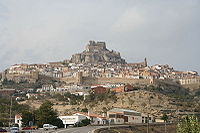 Morella castle and wall, Castellón province
Morella castle and wall, Castellón province
The origins of present day Valencia date back to the former Kingdom of Valencia (Regne de València), which came into existence in the 13th century. James I of Aragon led Christian conquest and colonization of the existing Islamic taifas with Aragonese and Catalan people in 1208 and founded the Kingdom of Valencia as a third independent country within the Crown of Aragon in 1238.
In 1707, in the context the War of the Spanish Succession, and by means of the Nueva Planta decrees, king Philip V of Spain subordinated the Kingdom of Valencia, and the rest of the countries belonging to the former Crown of Aragon and which had retained some autonomy, to the structure of the Kingdom of Castile and its laws and customs. As a result of this, the institutions and laws created by the Furs of Valencia (Furs de València) were abolished and the usage of the Valencian language in official instances and education was forbidden. Consequently, with the House of Bourbon, a new Kingdom of Spain was formed implementing a more centralized government than the former Habsburg Spain.
The first attempt to gain self-government for the Region of Valencia in modern-day Spain was during the 2nd Spanish Republic, in 1936, but the Civil War broke out and the autonomist project was suspended.[13] In 1977, after Franco's dictatorship Valencia started to be partially autonomous with the creation of the Consell Pre-autonòmic del País Valencià (Pre-autonomous Council of the Valencian Country),[14] and in 1982 the self-government was finally extended into a Statute of Autonomy (devolved government) creating several self-government institutions under the Generalitat Valenciana. The first democratically elected President of the Generalitat Valenciana, Joan Lerma, took office in 1982 as part of the transition to autonomy.[15]
The Valencian Statute of Autonomy make clear that Valencia is intended to be the modern conception of self-government of the Valencian Country from the first autonomist movements (autogovern) during Second Spanish Republic, but also joining it to the traditional conception of Valencian identity, as being the successor to the historical Kingdom of Valencia (furs).[16] In fact, after a bipartisan reform of the Valencian Statute of Autonomy in 2006, it records the foral civil law, using the traditional conception of a kingdom, and, on the other hand, it also recognizes Valencia as a nationality, in accordance with the modern conception.
Geography
Relief
The inland part of the territory is craggy, with some of the highest peaks in the Valencia and Castellón provinces forming part of the Iberian mountain range. The mountains in the Alicante province are in turn a part of the Subbaetic range.
The most emblematic mountain of the Valencian Community is the Penyagolosa, in the Alcalatén area. It is widely thought to be the highest peak with 1,813 m, but actually the highest peak is the Calderón (1,839 m) located in the Rincón de Ademuz, a Valencian exclave between Aragon and Castile-La Mancha. The most emblematic mountain in the southern part of the territory is the Aitana (1,558 m).
The rather thin coastal strip is a very fertile plain mainly free of remarkable mountains except those around the Cap de la Nau area in northern Alicante province and the Peníscola area in the Castellón province. Typical of this coastal area are wetlands and marshlands such as L'Albufera close to Valencia, El Fondo in Elx/Elche and Crevillent, La Marjal near Pego or El Prat in Cabanes, also the former wetlands and salt evaporation ponds in the Santa Pola and Torrevieja area. All of them are key RAMSAR sites which make Valencia of high relevance for both migratory and resident seabirds and waterbirds.
There are many important coastal dunes in the Saler area near the Albufera and in the Guardamar area, both of them were planted with thousands of trees during the 19th century in order to fix the dunes, thus forming now protected areas of remarkable ecologic value.
In addition to mainland Valencia, the Valencian territory administers the tiny Columbretes Islands and the coastal inhabited islet of Tabarca.
Climate
Valencia has a generally mild climate, heavily influenced by the neighbouring Mediterranean sea. Still, there are important differences between areas:
- Proper Mediterranean climate (Köppen Csa). It roughly goes along the coastal plain from the northernmost border through the Benidorm area (cities included here are, amongst others, Castellón de la Plana, Gandia and Valencia). It covers in various grades the lower inland areas. In this area, winters are cool, summers are long, dry and hot; rainfall occurs mostly during spring and autumn, usually totalling around 600 mm. with a remarkably wetter micro climate in the Marina Alta and the Safor comarques just north of Cap de la Nau cape, which accumulates an average of up to 1000 mm. due to an orographic lift phenomenon.
- Mediterranean to continental Mediterranean climate (Köppen Csa) and highland climate (Köppen H). These are the innermost lands and those at a higher elevation (cities included here are, amongst others, Alcoi, Morella, Requena and Villena). Here winters are cool to cold, especially at night (a few days of snow are not unusual), summers mild to hot and rainfall more evenly distributed through the year. The lower registered temperatures in the Valencian Community were in these inland areas during the cold wave of 1956. Temperatures plunged to nearly -20°C; as in Vistabella del Maestrat (-19°C) and Castellfort (-17°C).[17]
- Mediterranean to semi-arid climate (Köppen BSk). It roughly goes along the coastal plain from La Vila Joiosa through the southernmost border of the region (cities included here are, amongst others, Alicante, Elx/Elche, Orihuela and Torrevieja). Summers are very long, hot to very hot and very dry, winters are cool to mild and its most prominent feature is a very scarce precipitation, typically below 300 mm. per year which is most likely to happen during spring and autumn. The reason for this lack of precipitation is the marked rain shadow effect caused by hills to the west of the Alicante province (and, to a lesser degree, those in the northern part of the province which, in turn, enhance the inverse orographic lift effect around Cap de la Nau).
Hydrography
There are only two major rivers: the Segura in the Alicante province (whose source is in Andalusia) and the Júcar (Valencian: Xúquer) in the Valencia province (whose source is in Castile-La Mancha) both are subjected to very intense human regulation for cities, industries and -specially- agricultural consumption. The river Turia (Valencian: Túria) is the third largest and has its source in Aragon. Most rivers in the area, such as the Vinalopó, are usually short, and have little current (due to agricultural usage, climatic reasons or both) and often completely dry during the summer. Other Valencian rivers are the Serpis and Sénia.
Demographics
Main article: Valencian people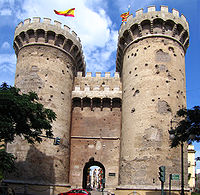 Quart Towers, city of Valencia
Quart Towers, city of Valencia
 Castle of Santa Bárbara, Alicante
Castle of Santa Bárbara, Alicante
 Old quarter of Castellón de la Plana
Old quarter of Castellón de la Plana
The Valencian population traditionally concentrated in localities with fertile cultivation and growing lowlands by the most important rivers (Júcar, Turia, Segura, Vinalopó), also in harbour cities important to the agricultural trade.
The most important population centers used to be, during the Roman times, Sagunt and Dénia; later on in history, Valencia, Alicante, Xàtiva, Orihuela, Elx/Elche, Gandia, and Vila-real and, more recently, Alzira and Castellón de la Plana.
With a total population of 5,111,706 (2009),[18] the Valencian Community ranks the 4th most populated autonomous community of Spain. The population density which is higher in the central and southern regions and minor in the northern and inner ones, is derived from the traditional distribution of people which originated in the orographic characteristics of the Valencian territory and the possibility to obtain irrigated land agriculture. Demographics were also affected by (being perhaps the exception to the mentioned distribution) the great industrial activity and the commerce of agriculturally derived products during the 20th century of noncoastal cities like Alcoi, Elda, Ontinyent, Petrer, Villena, and La Vall d'Uixó.
In the last years, concentration in the provincial capitals and its metropolitan areas has augmented considerably (e.g. Torrent, Mislata, Paterna, Burjassot, San Vicente del Raspeig/Sant Vicent del Raspeig, etc.) especially in all the coastal cities and towns. Thus, traditionally small populations such as Benidorm or Torrevieja have undergone a considerable population increase (still more remarkable during summertime) due to the seasonal migration of tourists.
Therefore, Valencia's population is nowadays clearly urban and coastal, also influenced by seasonal tourism. See major core cities (municipalities) and metropolitan areas of the Land of Valencia:
Rank Municipality Province Population 1 Valencia Valencia 809,267 2 Alicante Alicante 334,418 3 Elx/Elche Alicante 230,822 5 Castellón de la Plana Castellón 180,690 6 Torrevieja Alicante 101,091 7 Orihuela Alicante 87,113 8 Torrent Valencia 79,843 9 Gandia Valencia 79,430 10 Benidorm Alicante 71,198 Rank Metropolitan Areas Province Population 1 Valencia Valencia 1,705,742 2 Alicante–Elx/Elche Alicante 785,020 3 Castellón de la Plana Castellón 386,906 4 Alzira–Xàtiva Valencia 348,582 5 Benidorm–La Vila Joiosa Alicante 183,253 Economics
 Skyline of Benidorm
Skyline of Benidorm
Valencia conforms an elongated territory, with a rather steep and irregular orography that has made communications and the exploitation of the soil historically difficult, despite the soil being particularly fertile in the coastal plain. This coastal axis has facilitated connections with Europe, either by sea through the Mediterranean, or by land through Catalonia.
The natural resources of the Valencian territory are small with regard to minerals other than the important marble quarrying industry in the Alicante province.
As for hydrological resources (see Geography above) there is a demand of water superior to the supply, making this imbalance especially serious in the Alicante province. In years when drought is particularly severe, the problem is mitigated if necessary, with occasional nocturnal restrictions during Summer and water-bearing subterraneans exploitation. This remains a source of harsh controversy over hydrological resources with neighbouring regions such as Castile-La Mancha and Catalonia.
Due to the secondary and tertiary sectors boom by the times of the Spanish miracle during the 1960s, the agricultural sector has seen its relative importance reduced over time (not so the absolute figures), but it remains to be credited -under the form of citrus cultivation for the export market- for the first economic boom by the late 19th century after centuries of slow development, if not decay. Castellón and Valencia provinces still have thousands of hectares of citrus producing groves and it continues to be a major source of income on the countryside. In the Alicante province, citrus is also present but agriculture is more diversified with a higher presence of vegetables, especially in the Vega Baja del Segura area.
The high insulation rate and overall stable weather which during the Summer may pose a threat to water supplies either for agricultural or human consumption, conversely allow tourism to be the main economic industry with a very high density of residential housing along the coast occupied by locals, people from inland Spain and from other EU countries (mostly from the British Isles, Benelux, Germany and Scandinavia) which seasonally boost population (and hydrological demands) in the summertime.
In 2004, Valencia's GDP was 93.9% of the European Union average[19] even though this figure may be affected positively by the important presence of foreign residents either from other regions of Europe or economic immigrants which are not properly represented in the official statistics. Growth rates after 2004 have been significant in overall Spain and additional progress from present figures is going on as of 2007.
In 2008, the Land of Valencia generated 9.7% of the Spanish GDP. In human resources, the rate of unemployment was located over 21% in 2009 being greater among women,[20] and the rate of activity reached 56.8% in 2002. The typical Valencian business is rather small and medium company, mainly family-owned and operated, although there are some multinationals.
In addition to tourism, the Valencian economy is characterized by a marked exporting dimension, being the second exporting Spanish autonomous community, constituting 12% of the national total. The major exports are agricultural products, ceramic tiles, marble products and cars (Ford has an assembly line in Almussafes) among others, which make the port of Valencia one the busiest in Spain.
In 2010, the Valencian Community ranked the 100th largest country subdivision by GDP (nominal), just behind Rio Grande do Sul state (Brazil) and ahead Nord-Pas-de-Calais (France).
Politics
Institutions of government: La Generalitat
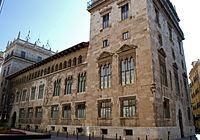 Palau de la Generalitat Valenciana, seat of the Valencian government
Palau de la Generalitat Valenciana, seat of the Valencian government
In the process whereby democracy was restored in Spain between 1975–1978, the nationalist and regionalist parties pressed to grant home rule to certain territories in Spain. The constitution of 1978 opened a legal way for autonomous communities to be formed from provinces with common historical and cultural links. In recognition of the Region of Valencia as a historical nationality of Spain, and in accordance to the second article of the Spanish Constitution which grants autonomy to the "nationalities and regions" that comprise the Spanish nation, Valencia was granted self-government and constituted itself as an autonomous community in 1982, with the promulgation of its first Statute of Autonomy, the basic organic law, later approved by the General Courts of Spain.
All autonomous communities were organized politically within a parliamentary system; that is, the executive branch of government. The "President" is dependent on the direct support of the legislative power, whose members elect him by majority.
A new Statute of Autonomy was promulgated in 2006. The government of Valencia is represented by the Generalitat Valenciana (statutorily referred to simply as La Generalitat) constituted by three institutions:[21]
- the Corts Valencianes (Valencian parliament), the legislature, which is to be integrated by a minimum of ninety-two representatives (diputats) elected through universal suffrage by proportional representation for a four-year period;
- the President of the Generalitat Valenciana elected by the Courts from which s/he must obtain the vote of confidence; the current President is Alberto Fabra Part.
- the Council of the Generalitat Valenciana (Valencian government), a collegiate institution with executive powers, integrated by the President him/herself and the cabinet members appointed by him/her.
The Generalitat can also be integrated by the institutions that the Valencian Courts create. The Courts have approved the creation of the Síndic de Greuges (the Ombudsman), the Sindicatura de Comptes (Public Audit Office), the Consell Valencià de Cultura (Valencian Council of Culture), the Acadèmia Valenciana de la Llengua (Valencian Academy of the Language), the Juridic and Consultative Council and the Social and Economic Committee.
Valencian symbols
The official Valencian anthem is the Hymn of the Regional Exhibition of 1909 (in Valencian, L'Himne de l'Exposició), in whose composition the old hymn of the City of Valencia of the 16th century is included. The emblem of the Valencian Generalitat includes the seal of King Peter IV of Aragon, representative of the historical Kingdom of Valencia, whose shield is inclined towards the right, or, four bars Gules.
The official flag, also known as Senyera Coronada or Crowned Senyera is the same as Valencia's City flag, which, in turn, is a historical derivation of the Senyera, the heraldic symbol of the Crown of Aragon, also used today with few variations in all the former Kingdoms and Counties which were a part of this crown. There are also a number of Valencian private and civil entities such as trade unions,[22] cultural associations,[23] or political parties[24] which simply use the Senyera as Valencian flag.
Other symbols are used at different levels by the Valencian society, like the heraldic animals of rat-penat (a bat) and drac alat (a winged dragon which was the emblem of James I), or the music of the Muixeranga, among others.
Languages
Valencian and Spanish are the official languages of Valencia. Spanish is the official language of the Spanish state,[n 1] while Valencian is the language considered by the Statute of Autonomy as llengua pròpia ("own language" or "language proper" to the territory). Valencian is traditionally spoken in the densely populated coastal areas rather than inland, where many places have Spanish as their traditional language, also those areas incorporated into the provinces of Alicante and Valencia at their creation in 1833 and which did not form part of the historical Kingdom of Valencia. Consequently, the 1984 Law on the "Use and Education of Valencian" defines certain municipalities as "predominantly Spanish-speaking", and allows them some few optional exceptions as to official use of Valencian, even though the right to use and to receive education in Valencian is guaranteed by the Statute of Autonomy (Art. 6.2) anywhere in Valencia.
Knowledge of Valencian in
the Valencian CommunityCan understand 76% Can speak 53% Can read 47% Can write 25% Source: Acadèmia Valenciana de la Llengua (2004). Enquesta sobre la situació del valencià. Even in areas which formed part of the former Kingdom of Valencia, the knowledge and use of Valencian has diminished by language shift (especially relevant during the Francoist era) also influenced by immigration from other parts of Spain and the world. The knowledge of Valencian in those areas defined as "predominantly Valencian-speaking" by the Generalitat Valenciana (83% can understand, 58% can speak)[25] is scarcely any higher than in Valencia as a whole (see table).
Valencian is regulated by the Valencian Academy of the Language (Acadèmia Valenciana de la Llengua, AVL), created in 1998. The law that instituted the Academy, originally declared that Valencian was part of the same linguistic system that the former territories of the Crown of Aragon—namely Catalonia and the Balearic Islands—recognize as their "own language" or "language proper" to their territories.[26] Note, that, as of 1996, Valencian was considered a dialect of Catalan by most linguists.[27] However, in a subsequent official statement, in 2005, the AVL stated that the language spoken in Valencia is the same language that is spoken in Catalonia and the Balearic Islands, and that the different varieties constituted a "single language" which refers to the term "linguistic system" used in the previous law.[28] The Institute of Catalan Studies (Institut d'Estudis Catalans, IEC), also considers Catalan and Valencian to be the same language. Even though phonetic differences are evident, written standard Valencian differs only slightly from written standard Central Catalan.[29] There is also a Valencian Sign Language which has been granted a special protection from the Statute of Autonomy[30] for those Valencian deaf persons.
Many Valencians, as well as the Valencian political parties, think that early Valencian literature preceded Catalan literature; they consider Catalan to be a product or early Valencian and a different language.[27] Politically, it's feared that placing Valencian as a dialect of Catalan will put Valencia in a vulnerable position in front of Catalonia.[27]
Aside from the purely philologic criteria, the traditional and usual term to name the language in Valencia is "Valencian". The widespread usage of this term by citizenry and all major parties does not necessarily deny nor endorse its Catalan linguistic filiation. Both Catalan and Valencian have slightly different standards, something which has produced some confusion as to whether they are both regarded as the same language or not. Thus, some Spanish government documents contain different versions for Catalonia and Valencia,[31] then, in the 2005 referendum to approve the proposed European Constitution the Spanish government at first distributed identical translations of the Constitutional Treaty in standard Catalan, the same for Catalonia and Valencia. This provoked a vocal reaction of the Valencian regional government demanding the translation to be in standard Valencian, once it was approved, then, in turn, the Catalan government, as a means to endorse philologic identity between Catalan and Valencian, assumed the Valencian standard and did not use the standard Catalan one in the leaflets used in Catalonia.[32]
In this regard, the main conservative party in Valencia, the ruling People's Party, mostly does not address the question about the filiation of Catalan and Valencian, while, effectively, endorsing the Valencian standard which is most consistent with Catalan; in spite of this, it may be quite vocal in reacting and defending "Valencian translations" in occasions like the one of the European referendum mentioned above. Furthermore, the PP it includes a right-wing group sympathetic or absorbed from the Blaverism movement, which opposes considering these two as a single language.
Education
Main article: Education in SpainState Education in Spain and the Valencian Community is free and compulsory from six to sixteen years of age. The current education system is called LOE (Spanish: Ley Orgánica de Educación, Valencian: Llei Orgànica d'Educació).[33]
Levels
- From three to six years: Preparatory School (Spanish and Valencian: Infantil, popularly known as Preescolar)
- From six to twelve years: Primary School (Spanish: Primaria, Valencian: Primària)
- From twelve to sixteen years: Compulsory Secondary School (Spanish: Secundaria, Valencian: Secundària)
- From sixteen to eighteen years: Post-Secondary School (Spanish: Bachillerato, Valencian: Batxillerat)
Children from three to five years old in the Valencian Community have the option of attending the infantil or Pre-school stage, which is non-compulsory and free for all students. It is regarded as an integral part of the education system with infantil classes in almost every primary school. There are some separate nursery schools.
Valencian students aged six to sixteen undergo primary and secondary school education, which are compulsory and free of charge. Successful students are awarded a Secondary Education Certificate, which is necessary for entering further (optional) education as for their University or Vocational Studies. Once students have finished their Bachillerato (Valencian: Batxillerat), they can take their University Entrance Exam (Spanish: Pruebas de Acesso a la Universidad, Valencian: Proves d'Accés a la Universitat), known commonly in Spanish as La Selectividad (Valencian: Selectivitat) which differs greatly from region to region.
The secondary stage of education is normally referred to by their initials, e.g. ESO standing for Educación Secundaria Obligatoria (Valencian: Educació Secundària Obligatòria).
Universities
The Valencian Community is home to a number of prestigious universities (Spanish: universidades, Valencian: universitats) like the University of Valencia, founded in 1499. At the request of James I of Aragon, Pope Innocent IV in 1246, authorized by a papal bull the establishment of estudis generals in Valencia. The University Statutes were passed by the municipal magistrates of Valencia on April 30, 1499; this is considered to be the 'founding' of the University. In 1501, Pope Alexander VI signed the bill of approval and one year later Ferdinand II of Aragon proclaimed the Royal Mandatory Concession. Only very meagre accounts have been preserved of the practical workings of the university. From the time of its foundation the courses included Latin, Greek, Hebrew, Arabic, philosophy, mathematics, physics, theology, Canon law, and medicine.
Nowadays the Polytechnic University of Valencia has become one of the most prestigious universities in Spain, according to its technology, investigation, several degrees offering and closed relations with the most important universities in the world such as Cambridge, Oxford and Harvard. Most faculties and colleges are seat in the city of Valencia, with some branches in Gandia and Alcoi.
Other universities are University of Alicante, Miguel Hernández University in Elx/Elche, Jaume I University and Valencian International University in Castellón de la Plana, Catholic University of Valencia, and CEU Cardenal Herrera University in Valencia.
Transport
Air
The Valencian Community is served by two international airports, Alicante Airport, which is mainly tourist-oriented and Valencia Airport, which carries more business traffic. There is a third airport located in the north of the Valencian territory, in Castellón province. The airport was officially opened on 25 March 2011, however it is still inoperative.[34]
Currently, there is also a new terminal being built at Alicante Airport which is expected to open by the end of March 2011. New Alicante Terminal (NAT) will replace the other two existing terminals T1 and T2, doubling the passenger capacity of the airport to 20m passengers per annum. Valencia airport is also being expanded to serve the higher passenger demand due to new flight connections to the city.
Train
The Valencian Community has a quite extended rail system which connects the principal cities with the rest of Spain such as the Euromed towards Catalonia and Alaris towards Madrid, or northern and southern Spain, both run by the Spanish national rail company RENFE.
In December 2010 was opened the high speed rail (AVE) Madrid–Valencia, part of the Madrid–Levante high-speed rail line. The current high speed station, Valencia-Joaquín Sorolla, is a provisional station located in the outskirts of the city of Valencia. It is expected in the coming years the high speed line Madrid–Valencia will reach Valencia Central Station through an underground tunnel.
High speed rail Madrid–Alicante is planned to open in 2012, with also a provisional station in the outskirts.
There are some medium-range plans for further high speed connections, like the Valencia–Bilbao link via Zaragoza or the Mediterranean high speed rail corridor.
In addition, the Generalitat Valenciana has planned on building a regional high speed rail through the coast, to connect all major coastal cities like Valencia, Gandia, Dénia, Benidorm, La Vila Joiosa, Alicante and Torrevieja.
Commuter rail and Metro
Cercanías (Valencian: Rodalies) is the commuter rail service that serves all three provincial capitals of Valencia and their metropolitan areas. It is operated by Cercanías Renfe, the commuter rail division of RENFE.
While the Valencian-owned company, Ferrocarrils de la Generalitat Valenciana (FGV) operates a tram-train line between Alicante, Benidorm and Dénia. It also operates the city tram and metro system of Valencia (Valencia Metro) and Alicante (Alicante Tram). There is as well a third new tram and trolleybus system being built in Castellón de la Plana and its metropolitan area. Additionally both, Valencia metro and Alicante tram are being extended to serve uncovered areas, like the new tram line planned to open in the coming months towards the University of Alicante and Sant Vicent del Raspeig.
Seaports
Main article: List of seaports of the Valencian CommunityGastronomy
Main article: Valencian cuisine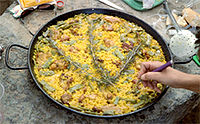 Valencian paella
Valencian paella
The Valencian gastronomy is of great variety, although their more international dishes are rice based (arròs in Valencian), like the Valencian paella known worldwide. Rice is a basic ingredient in many of the typical dishes, like the arròs negre, arròs amb costra, arròs a banda, arròs a la pedra, arròs caldós, among many.
The Valencian Mediterranean climate favors the cultivation of vegetables and citrus fruits, with the cultivation of the orange being perhaps of highest importance as one of the typical fruits of Valencian agriculture.
Drinks
Orxata (known in Spanish as Horchata), whose traditional nucleus of elaboration is Alboraia, is a typical drink, accompanied with fartons. Also traditional are the production of coffee liqueur (typical of Alcoi), and mistela (in Marina Baixa and Hoya de Buñol/Foia de Bunyol).
Desserts
The great majority of desserts typical of Valencia have their origin in Arabic times and play an important part in the local festive activities. Some are internationally famous. Xixona is the place of traditional manufacture of turrón or torró (a soft nougat), consumed during Christmas in Spain and the rest of the Hispanic world. In Casinos the turrón is typical too but the most important manufacture of the village is peladillas (dragées and sugared almonds). In Xàtiva, the arnadí, a dessert elaborated with pumpkin is made. And in Orihuela and its region the almojábanas.
Sports
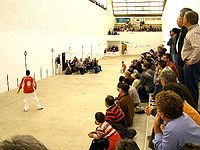 Valencian pilota match
Valencian pilota match
Football (association football) is the most widely known sport. There are teams in every town or village, four of which are currently playing in La Liga, Spain's premier league: Valencia CF, Levante UD and Villarreal CF. There are many big teams elsewhere, such as CD Alcoyano, Hércules CF, CD Castellón or Elche CF.
Professional Basketball is represented by one team, Valencia BC in the top league, the ACB. Also, Ros Casares Valencia is a female basketball team, which is the current champion of the Spanish Women's League and finalist of the Euroleague Women.
Motorcycle races are very popular, as the Circuit of Valencia race track and its hosted Valencian Community Grand Prix prove.
The autochthonous Valencian sport is the Valencian pilota, which features a professional Valencian Pilota Squad for international matches with related ball games all around the world. This sport has many variants, that may be played at the streets or at special courtfields like the trinquet.It may also be played by teams or on individual challenges. An amazing trait of this sport is that spectators may sit very close or even in the middle of the court. Even while the match is ongoing bookmakers take bets for reds or blues, since these are the colours players must wear, red being the colour of the strongest team or player. The Valencian pilota can be traced to the 15th century, but it was abandoned during modern times, this decadence is being fought back with TV broadcasts, new built colleges have courtfields and a new professional players firm, ValNet.
Another relevant game is the pigeon sport, with an autochthonous dove race being trained, the gavatxut valencià.
Petanca and its variant Calitx are traditional sports as well, especially in towns or among elders.
Regarding female professional sports, Valencian Handball rules the Spanish Honor division league with more than half of the teams, such as Astroc Sagunt, Cementos La Unión Riba-roja and Orsan Elda Prestigio.
Provinces
Traditionally the land is divided into comarques, and in 1833 was, along with the rest of Spain, divided into provinces according to a decree from minister Javier de Burgos. There are 32 comarques, and three provinces: Castellón/Castelló, Valencia/València, and Alicante/Alacant (names in Spanish/Valencian).[35]
Here is a list of some of the largest cities.
- Valencia (Valencian: València), population 796,549, capital of the province of the same name, on the river Turia. Famous festival of the Falles on March 19.
- Alicante (Valencian: Alacant), population 319,380, capital of the province of the same name, in the Mediterranean coast. Famous for its hard nougat or turrón duro (Valencian: torró dur) and Postiguet, Albufereta and Sant Joan Beaches. The famous festival of the Bonfires of Saint John is in June. Its city hall and the Santa Barbara Castle are historic monuments.
- Elche (Valencian: Elx), population 215,137, famous for the wood of the palm tree called Palmeral, and for the Misteri d'Elx, two-day festival of singing and street drama that acts out the Assumption of the Virgin Mary, declared by UNESCO as part of all humankind's oral heritage.
- Castellón de la Plana (Valencian: Castelló de la Plana), population 167,455, capital of the province of Castellón.
- Torrevieja, population 84,348, in the south, important tourist center with many hotels, apartments and tourist accommodations; includes La Mata Beach.
- Gandia (Spanish: Gandía), population 77,943, is another important tourist center, situated on the Costa del Azahar.
- Orihuela, population 75,009, on the Segura River, historic city with palaces, churches and the Cathedral, a highly productive area for farm products such as oranges, lemons and the like.
- Benidorm, population 67,492, a major holiday resort, dubbed Beniyork because of its many skyscrapers, including Spain's tallest, the 52-story Gran Hotel Bali.
- Alcoi (Spanish: Alcoy), population 60,590, an important industrial area for textile products, with characteristical 19th century modernist buildings and with the most well known Moors and Christians festivities.
- Elda, population 55,571, important production center for shoes and wine in the Vinalopo area.
- Villena, population 35.000, important production of shoes and wine, with many historical and monumental visits. Also, fiestas of Moros y Cristianos, one of the most important in the Community, with the highest participation.
- Vila-real (Spanish: Villarreal), population 46,696, important producer of ceramics and brick.
See also
- List of Valencians
- Nationalities in Spain
- List of seaports of the Valencian Community
Notes
- ^ Spanish is referred too as castellano (Valencian castellà) a term that has a wider meaning than the English term Castilian, and, depending on context, can refer to either the entire Spanish language or just the dialects spoken on the Iberian Peninsula.
References
- ^ a b Languages across Europe. Valencian, valencià, BBC
- ^ Art. 6.2 of the Valencian Statute of Autonomy
- ^ Art. 6.2 of the , by effect of Art. 7 from Organical Law 1/2006, April 10th[dead link]
- ^ Terms mainly used from the Department of Tourism of the Valencian Government. See official publications, and an exemple of using "Region of Valencia". The other term, "Land of Valencia" is also used by this department
- ^ Scenery in Land of Valencia, edited by the Valencian Agency of Tourism
- ^ CVNews, English-language magazine published by the Valencia Region Tourist Board
- ^ Javier Paniagua. "Un solo territorio y varias identidades". http://www.ub.es/histodidactica/historia/Paniagua-Identitat.swf. "en 1979 la UCD ya había abandonado la expresión 'País Valenciano' (...) País Valenciano quedó en manos de las opciones de izquierdas PSOE, PCE, PSPV, PSP y otros"
- ^ Centre International de Recherche sur le Bilinguisme, Lorne Laforge (1987). Actes du Colloque international sur l'aménagement linguistique. Presses Université Laval. pp. 156. ISBN 2763771297. http://books.google.com/books?id=BcimH30ikQgC&pg=PA156&dq=%22pais+valencia%22+%22valencian+country%22&hl=es.
- ^ Kas Deprez, Theo Du Plessis, Lut Teck (2001). Van Schaik Publishers. ed. Multilingualism, the Judicial Authority and Security Services: Belgium, Europe, South Africa, Southern Africa. p. 38. ISBN 0627025080. http://books.google.com/books?id=GFViAAAAMAAJ&q=%22pais+valencia%22+%22valencian+country%22&dq=%22pais+valencia%22+%22valencian+country%22&hl=es&pgis=1. "(...) (Valencian Country, like Basque Country) (...) a compromise was reached with the name "Valencian Community""
- ^ Colman Andrews (2006). Harvard Common Press. ed. Catalan Cuisine: Vivid Flavors from Spain's Mediterranean Coast. ISBN 1558323295. http://books.google.com/books?id=-K_ekX6BVXsC&pg=PA15&dq=%22pais+valencia%22+%22region+of+valencia%22&hl=es.
- ^ "...la tradició valenciana provinent de l'històric Regne de València es va trobar amb la concepció moderna del País Valencià i va donar origen a l'autonomia valenciana..." Preamble of Valencian Statute of Autonomy (reformed in 2006)
- ^ According to article Valencia from Britannica Online Encyclopedia
- ^ Proyecto de Estatuto de Autonomía para el País Valenciano (1937)
- ^ Real Decreto-Ley 10/1978, de 17 de marzo, por el que se aprueba el Régimen Preautonómico del País Valenciano
- ^ "Fallece el expresidente preautonómico de la Generalitat Enrique Monsonís, Dirigió el Consell entre 1979 y 1982". El Pais. 2011-10-07. http://www.elpais.com/articulo/espana/Fallece/expresidente/preautonomico/Generalitat/Enrique/Monsonis/elpepuesp/20111007elpepunac_12/Tes. Retrieved 2011-11-02.
- ^ Preamble on Valencian Statutes of Autonomy 1982 and 2006: "Aprovada la Constitució Espanyola, va ser, en el seu marc, on la tradició valenciana provinent de l'històric Regne de València es va trobar amb la concepció moderna del País Valencià i va donar origen a l'autonomia valenciana [...]"
- ^ Lower temperatures of 1956
- ^ Instituto Nacional de Estadística (INE) (January 2009). "Autonomous communities of Spain by population". http://www.ine.es/jaxi/tabla.do?path=/t20/e260/a2010/l0/&file=ccaa01.px&type=pcaxis&L=0.
- ^ Eurostat GDP figures 2004
- ^ Unemployment rate reaches 23% of the total working population
- ^ Third Section, First Chapter of the Statute of Autonomy of the Valencian Community
- ^ See logo of one of major trade unions: CCOO-PV
- ^ See usage of the Senyera by a Valencian cultural association: ACPV
- ^ See usage of Senyera by political parties EUPV, Bloc Nacionalista Valencià, Green Parties, amongst others, whose combined participation in the Autonomous Elections of 2007 achieved 9% of the total votes.
- ^ Acadèmia Valenciana de la Llengua (2004). Enquesta sobre la situació del valencià.
- ^ LLEI 7/1998, de 16 de setembre, de la Generalitat Valenciana, de Creació de l'Acadèmia Valenciana de la Llengua. (1998/7973)
- ^ a b c Fernand de Varennes (December 1996), Reading Literacy in an International Perspective, National Center for Education Statistics and U.S. Department of Education, pp. 125–126, http://nces.ed.gov/pubs97/97875.pdf#page=123
- ^ Dictamen de l’Acadèmia Valenciana de la Llengua sobre els principis i criteris per a la defensa de la denominació i l’entitat del valencià. First bullet point under "Dictamen".
- ^ See Valencian language for more discussion and examples
- ^
“ Article 13,4: La Generalitat garantirà l’ús de la llengua de signes pròpia de les persones sordes, que haurà de ser objecte d’ensenyament, protecció i respecte.
The Generalitat shall grant the use of the sign language own to deaf people, which shall be taught, protected and guaranteed.” - ^ For example, the temporary driver's license issued immediately after the practical driving test, and the translated versions of the Spanish constitution.
- ^ Cataluña asume la traducción valenciana de la Constitución europea (translation:"Catalonia assumes Valencian translation of EU Constitution text"), EL PAÍS newspaper. October 10th 2004.
- ^ http://www.mec.es/educa/sistema-educativo/loe/sistema-educativo-loe.html Sistema Educativo LOE by the Spanish Ministry of Education(Spanish Only)
- ^ http://www.aerocas.com
- ^ The names in both languages are official as per Ley 25/1999, de 6 de julio, por la que se declaran cooficiales las denominaciones Alacant, Castelló y València para las provincias que integran la Comunidad Valenciana.
External links
- Language Valencian Academy
- Official tourism webpage
- Valencia travel guide from Wikitravel
- Valencia in the Great Catalan Encyclopedia
- subway metropolitan area
Catalan/Valencian-speaking territories Catalan as the only official language 
Catalan as co-official language Catalan as co-official language only
recognized by the departmental governmentSpoken without official status Autonomies of Spain Autonomous communities 
Autonomous cities Plazas de soberanía Categories:- Articles with Valencian language external links
- Autonomous communities of Spain
- NUTS 2 statistical regions of the European Union
- Valencian Community
- States and territories established in 1977
- Regions of Europe with multiple official languages
Wikimedia Foundation. 2010.

